AgRiCuLtUre







Did you know you have access to free telehealth counseling at the touch of a button? Telehealth counseling, or teletherapy, is growing in popularity due to its convenience and accessibility. Build coping skills with confidential telehealth counseling from a trusted source.
Any Missouri farmer, rancher, farmworker, or immediate family member is eligible.

Funding provided by USDA NIFA Grant ID’s: 2020-70028-32728 and 2021-70035-35436.
Build coping skills with confidential, telehealth counseling from a trusted source.


Hayley (Cape) and Eric Glennon were married on November 5, 2022 exchanging their vows at First Baptist Church of Columbia with their reception held at The Country Club of Missouri. It was an absolutely picture perfect fall day with so many special touches that communicated their unique love story.
From the beginning of the wedding weekend, we knew this was going to be one big, fun party and, man oh man, did they deliver! Hayley had her mom’s wedding gown repurposed into a shorter dress and Eric donned a Kansas City Chiefs Red Jacket Club blazer from his grandfather that they wore to their rehearsal. What a start to the weekend!
Hayley’s and Eric’s traditional church wedding had a modern twist by featuring an arbor that the the groom’s dad, John hand made just for their big day adorned by gorgeous fall floral and pampas from Kailey Russell at Bare Roots. Tradition and trend were further blended with the bride’s processional song, a piano cover of a Fleetwood Mac’s “Everywhere”, and their good friend, Khalil Diya, acting as their officiant providing a sentimental and, at times, humorous touch when needed.
Although the couple chose to host their reception at a traditional country club, they wanted their reception to include the rustic touches that they both loved, quirky and fun details, and to weave in Hayley’s Kansas City roots. Through a warm fall color palette, beautiful rustic wood touches throughout the venue, wheat incorporated into the floral design, a Lakota infused espresso martini bar paired with Elianna’s donuts, and of course a KC BBQ inspired dinner, Hayley and Eric’s wedding was a direct reflection of their personalities and was something that had never been done at CCMO before!
Hayley and Eric carefully chose a team of vendors who perfectly executed their wedding day and allowed them to dance the night away, ending it as Mr. and Mrs. Glennon!


Planning & Design: Delight Events

Ceremony Venue: First Baptist Church of Columbia
Reception Venue: Country Club of Missouri
Rehearsal Venue: Cherry Street Cellar
Photography and Videography: Emmy Bee Photography
Floral: Bare Roots LLC
Rentals: A1 Party and Event Rental
Signage and Vintage Rentals: Pretty Little Things
Decor Rentals: Grace and Lace Rentals


Draping: US Rents It Jefferson City
Lit Letters: Alpha Lit Mid-Missouri
Makeup: Ali Somer Beauty
Hair: Aorist Salon (Kansas City)
Live Painting: Cindy Scott Artistry
DJ & Photo Booth: Complete Weddings
Coffee: Lakota Coffee Company
Donuts: Elianna’s Donuts
Desserts: Nothing Bundt Cakes


























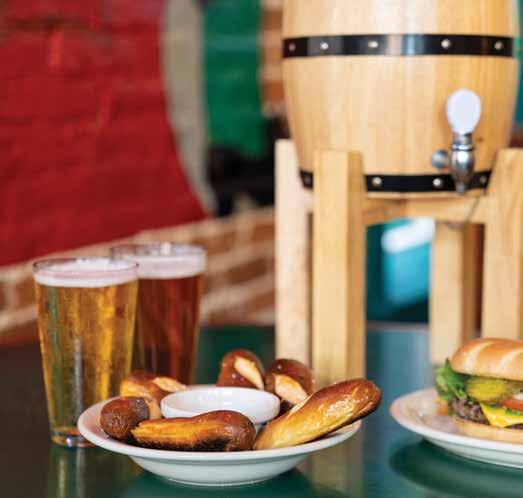






The vision of Missouri AgrAbility is to enhance quality of life for farmers, ranchers, and other agricultural workers with chronic diseases, disabilities and disorders so that they, their families, and their rural communities continue to succeed.
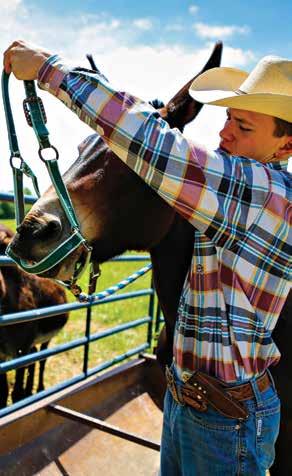







President Erica Pefferman | Erica@comomag.com
EDITORIAL
Publisher | Erica Pefferman Erica@comomag.com

Editor-in-Chief | Kim Ambra Kim@comomag.com




Digital Editor | Jodie Jackson Jr Jodie@comomag.com
DESIGN
Creative Director | Kate Morrow Kate@comomag.com
Senior Designer | Jordan Watts Jordan@comomag.com
MARKETING Director of Account Services
Amanda Melton Amanda@comomag.com
Marketing Representative Sarah Hempelmann Sarah@comomag.com
Marketing Representative Becky Roberts Becky@comomag.com
CONTRIBUTING PHOTOGRAPHERS
Anthony Jinson, Chris Padgett
MARKETING
Director of Sales | Charles Bruce Charles@comomag.com
Director of Events | Scott Callahan Scott@comomag.com
OUR MISSION
To inspire, educate, and entertain the citizens of Columbia with quality, relevant content that reflects Columbia’s business environment, lifestyle, and community spirit.
CONTACT
The COMO Companies
404 Portland, Columbia, MO 65201 (573) 499-1830 | comomag.com @wearecomomag
SUBSCRIPTIONS
Magazines are $5.95 an issue. Subscription rate is $54 for 12 issues for one year or $89 for 24 issues for two years. Subscribe at comomag.com or by phone.

CONTRIBUTING WRITERS
Taylor Ambra, Candice Ball, Kathryn Dotson, Lauren Sable Freiman, Jules Graebner, Hoss Koetting, Amanda Long, Michelle Terhune, Jennifer Truesdale, Emmi Weiner, Dr. Brian Yearwood
Igrew up thinking I lived on a farm. I like to joke now and tell people that I was once a ranch hand. In the back of a neighborhood, o Route B, down a gravel road, was the Wagon Wheel Ranch. My childhood home. e house that built me.
What made this 15-acre plot of memories a ‘ranch’ was simply a sign that hung above the driveway that proclaimed, “Wagon Wheel Ranch,” with two old wagon wheels hung on each side. row in a barn, a few horses, and our pet goat Billy ... I really thought I was roughing it on the ranch.
I am a city girl at heart, so therefore the “ranch life” was hard for me. (I am cracking up even typing that!) My dad is the father of four daughters — three of which hated farm chores. And by farm chores I mean the occasional waking up before 8 a.m. to clean out the barn or feed the horses.
e Wagon Wheel Ranch is where my nearest and dearest memories were created. So many of those stories are still talked about at family gatherings and we are brought to tears from the laughter. One of my favorites — my dad traveled for work when we were young, so my sisters and I were occasionally left to run the ranch. (I truly cannot say that without laughing.) One morning my oldest sister and I were sent to feed the horses. My mom is washing dishes and looks up in time to see the horses running past the kitchen window. Outside she hears my sister and me screaming.
After further investigation, she nds us in the hayloft screaming our heads o . We were scared to death of those horses, so all it took was one sideways glance for us to drop our buckets and take o running. Hearing my mom’s version of this story is even funnier!
Occasionally my sisters and I were known to strike up an attitude or complain and my parents liked to teach us valuable lessons. If we complained about the few easy chores they asked us to do, that would often be followed by a not-so-easy chore. One particular day our complaining led to us clearing the brush from an unused and overgrown horse stall. After about 15 minutes of weed-whacking, my sister and I thought it would be fun to hit up the costume box and wear prisoner uniforms for the rest of our shift.
Although the ranch work was hard, and the days were long, we always had fun! I walked our pet goat around on a leash. We dressed our barn cats up in doll clothes and always wondered why they hated us. I have thousands of memories ingrained in my heart.

We were all so sad when my parents sold that house. e day before closing, my oldest sister and I decided to visit the Wagon Wheel Ranch one last time. On our exit, we decided to shimmy up the post and take the ole’ wagon wheels with us. We tied them to the top of my sister’s Grand Am with our shoelaces and proudly took them to my parents’ new home (another shake-their-heads moment for Ken and Sherry).
Fun fact — my mom grew up on actual ranches in Wyoming and my grandpa was a real-life cowboy. So I de nitely know the di erence, and know that we were nowhere near roughing it on a ranch. Kudos to the real farmers and ranchers out there!
Above: Wagon Wheel Ranch’s Prisoner Work Release Program in August of ‘96 (a.k.a. my sister and I doing chores).

Top: My sassy self with our pet goat, Billy. ON THE COVER
Blue oyster mushrooms from Columbia Farmers Market vendor Booneslick Heritage Farm.
 KIM AMBRA , EDITOR-IN-CHIEF
KIM AMBRA , EDITOR-IN-CHIEF

TO PURCHASE GOLF BALLS, REGISTER, OR FOR MORE INFORMATION, VISIT:




or email Jes Baldwin at jbaldwin@woodhaventeam.org
OR SCAN THE QR CODE!
We take pride in representing our community well and we couldn’t do what we do without our COMO Magazine advisory board. Thank You!
Beth Bramstedt
Associate Pastor Christian Fellowship Church
Kris Husted
Senior Content Editor NPR Midwest Newsroom


Heather Brown Strategic Partnership Officer Harry S Truman VA Hospital




Chris Cottle
Walk Manager
Alzheimer’s Association Greater Missouri Chapter
Sam Fleury
Assistant Vice President, Strategic Communications, Columbia College
Alex George Owner Skylark Bookshop Executive Director Unbound Book Festival Author
Chris Horn
Sr. Reinsurance Manager
American Family Insurance
Amanda Jacobs
Owner Jacobs Property Management
Barbra Horrell Consultant Horrell Associates


Jeremiah Hunter
Assistant Police Chief Commander Investigations Bureau Columbia Police Department
Darren Morton Program Director Turning Point

David Nivens
Chief Executive Officer Midwest Computech






Megan Steen
Chief Operating Officer, Central Region Burrell Behavioral Health
Nathan Todd
Business Services Specialist First State Community Bank
Wende Wagner
Director of Philanthropy
The Missouri Symphony

MU’s greenhouse facilities provide a hands-on education.

Future Farmers of America has bolted into the 21st century, taking young men and women for the ride of their lives. And not just on horses or tractors.
43 years of the freshest local goods.
No matter who you are, how long you have lived here, or what you do for fun, everyone has their own CoMo. This year, we’re featuring local residents and asking them what makes their CoMo. From favorite places to grab dinner to our best-kept secrets for visitors to explore, they will be sharing what makes our city extraordinary to them. Because, in the end, it’s those memorable places and experiences that make it your CoMo.
What is your go to place to take a visitor in Columbia?

The District, downtown, of course! Start with coffee at Shortwave, food at Tellers, shopping at Poppy’s, and end with drinks at Top Ten Wines. Maybe a little late-night action at 9th St Public House. There is something for everyone in The District!


What’s your fave pastime in Columbia?
All of the above! My friends are the bartenders, services, and business owners downtown. SO downtown is where I want to be. But if I’m not downtown, I’m in my garden.
What do you think is Columbia’s best kept secret?
Still have to be the catacombs in North Village Arts District. It’s an evergrowing mix of handmade art and jewelry, coffee shops, record stores, artist studios, and so much more.

How would you describe Columbia in one word?
Hidden-Gem?! Does that work? If not vibrant!
Small business is the heart of Columbia. Walking into a one-of-a-kind shop lled with carefully selected pieces is one of the great small joys in life. One can feel the care and passion that is placed in every piece before it makes its way to the sales oor. Orchids & Art Custom Framing is just that kind of place.

Kelly and Carrie Coalier opened Orchids & Art Custom Framing when they moved back to Columbia from Las Vegas in 2001. While living in Las Vegas, Kelly managed a frame shop while Carrie managed an orchid shop.
“It was learning how to run your own business and getting the licenses and guring out the sales tax. And things like that, which we’ve gured out,” Carrie explains. “ at’s just a lot more paperwork.”
Around the shop, shelves are lled with stunning orchids in eclectic pots. eir colors run the gamut of the rainbow. Even more noticeable are the heavenly scents coming o the delicate blooms.
“If you go to a grocery store, you see one type of orchid, like the moth orchid. I try to carry other ones,” Carrie says. “Some people are surprised when they come in that, ‘Oh, is this an orchid, too, because it looks di erent?’ And I’m like, ‘Yes, there are many kinds.’” ere are about 30,000 di erent species of orchids, she adds.
Carrie tries to keep at least a dozen varieties of orchids on hand. e orchids are shipped from Hawaii. Most of the orchids that are sold are hybrids, which makes them less particular and more likely to thrive in houses far away from their intended environments. While there are native Missouri orchids, those require incredibly speci c conditions to thrive.
“And there are some lady slippers,” Carrie says, pointing out the lady slipper tattooed on her arm. “And some prairie orchids, but you have to know where to nd them. ey’re not just growing in your yard.”

Aside from purchasing orchids, people can bring in their orchids from home and have them repotted or rehabbed by Carrie. She suggests that orchids are ideal gifts for birthdays, Mother’s Day, Valentine’s Day, and Christmas.
e shop walls are adorned with exquisitely framed artwork, the frames nearly touching to make sure space is maximized. e styles

range from abstract to realism — each piece perfectly matched to a frame. All of the artwork is created and framed by Kelly, from photographs of local, natural areas to tourist attractions, as well as drawings and paintings of those subjects.
By combining the shops and opening their own store, Kelly and Carrie were able to start a family and have the exibility to take time as it was needed.
“It’s been nice because it’s exible because she can leave to go deal with kid’s stu , which is all the time,” Kelly says. “Our kids grew up in the various stores.”
Carrie laughs remembering some of that experience.
“It was nice to be able to bring them in as babies until they started crawling,” she says. “ en that didn’t work out.”
e opportunity to build a family as they have done is re ected in how their kids have taken artistic, entrepreneurial approaches to their own endeavors. Out in the parking lot, it is clear which car belonged to their middle child. It was an SUV covered in hand-painted artwork in a variety of styles, just like their dad’s.
“ ey just got their license. And this was our old car and he said, ‘Okay, this is your car now,’ and in one week it was all painted,” Carrie recalls. “We try to encourage it. at obviously comes from Kelly with his art background.”
98 Corporate Lake Dr Facebook: Orchids & Art Custom Framing

Your business is your passion. Sure, there are days that aren’t as great as others, but you keep pushing forward. You deserve a bank that backs your passion – one that asks “What’s next?” instead of “What for?” Our bankers are here to do our part to make your dream a reality. Whether you’re just getting started or if you want to take it to the next level, we’re the bank of making it happen. We’re The Bank of Missouri.




Let’s get started with a banker near you.
Every year around springtime, the calls start rolling in. A fawn was seemingly abandoned by its mother. An injured baby bunny was brought home by the family dog. A car hit a mother raccoon; its kits are lingering nearby. But who answers those calls?
In 2022, Jenny Romesburg, owner and founder of Jenny’s Wildlife Wonderland, answered that call for 23 squirrels, 51 opossums, two groundhogs, 11 raccoons, two foxes, a goose, seven skunks, 14 fawns, and 10 ducks for a total of 121 animals rehabilitated and released into the wild.
Nestled on 200 acres on the southwest side of Columbia, Jenny’s Wildlife Wonderland is currently the only nonpro t wildlife rescue in Boone County. Licensed with the Missouri Department of Conservation since 2014, its mission is to provide the best care possible for wildlife while under the organization’s impassioned care.
e rescue helps orphaned, abandoned, injured, and sick wildlife, specializing in neonate, or infant, mammals with the goal to rehabilitate and release the animals back into their natural habitat.



“I’m lucky I just happen to get to be the Mom that helps them get back to where they belong,” Romesburg says.
Romesburg’s passion for wildlife rehabbing was inspired by her grandfather, a hunter and woodsman with a heart for animals. He was prone to help any animals in need that he came across in the woods, granddaughter Jenny always eager
to help. When it came to choosing a career, Romesburg initially thought that being a conservation agent was the job for her. After college graduation, however, she took a job at the Central Missouri Humane Society as the foster/rescue coordinator for almost a decade.
“It was during my time [at CMHS] that I really gured out what I wanted to do with my life,” she recalls. “I knew I wanted to be on the front lines to help these animals, to be able to bring life back into them. at’s where this passion came full circle.”
Romesburg adds, “It also helps I’m fortunate enough to have the best husband in the world and a family that supports my dreams.”
Initially started in their barn, Jenny’s Wildlife Wonderland has grown exponentially in recent years with increased needs.
“My ultimate goal is to have one of those facilities you see in larger cities like Kansas City or St. Louis,” Romeburg explains. “Paid sta ng, vets on board, a dedicated building that would provide the animals the space they deserve.”
e biggest barrier to that goal, not surprisingly, is funding.
“In a perfect world we could nd someone to donate land for the facility, then we just continue to work and scrape to make it possible to help these animals,” she says. “It’s hard work but the animals are worth it. It’s all worth it.”
Jenny’s Wildlife Wonderland is a volunteer-run rescue that relies entirely on donations. As a 501c(3) nonpro t, all donations are tax-deductible and go directly to pay for food, formula, medical supplies, surgeries, and housing for the animals.
e rescue is always in need of volunteers. Anyone interested can contact the organization directly.
Worrying about things you didn’t worry about before
Loss of interest in things you used to enjoy (hobbies)
Wanting to withdraw from people and activities
Poor concentration, confusion; forgetfulness
Uncertainty or trouble making decisions
Relationship problems
Sad mood
Feeling anxious
Change in personality, irritability
Negative thinking
Increased smoking/drinking
Weight loss or gain, changes in appetite
Stomach or gastrointestinal problems
Poor or disturbed sleep
Clenching or grinding teeth
Chest pain
Poor hygiene
Do you recognize the signs and symptoms in yourself or someone you know?
Reach out to a loved one. Talk about how you are feeling.
Talk to your friends, clergy or medical provider.
Reach out to a mental health counselor.
Listen attentively and without judgement. Try to understand where they are coming from.
Share your concerns about their behavior, mood, appearance, etc. Ask questions about any changes you observe.
Encourage them to reach out/tell a family member.
It’s free, confidential and open 24/7
Upper Midwest Agricultural Safety and Health Center
umash.umn.edu
This resource was created by the Upper Midwest Agricultural Safety and Health Center (UMASH). Funding provided through a cooperative agreement from NIOSH/CDC, U54OH010170.

Using plants for medicine and, speci cally, to treat opioid addiction was a discovery Ethan Jones made because of a car wreck and subsequent addiction issues that grew from his treatment.
at experience is at the root of MindRight Wellness, a business that was born in Jones’s spare bedroom with a meager budget of $500. Initially, an online herbal health store, MindRight Wellness has ourished since 2021 in its brick-and-mortar location at 1009 E. Broadway.

e business’s genesis is incredibly personal for Jones, and he hopes to encourage the mindset that wellness means taking care of ourselves, respecting our bodies, and discovering natural ways to address a number of common health concerns.
“It goes back to when I was about 17,” Jones says, recalling a car wreck. “I had some surgeries, and I dealt with some addiction issues from some pills that I was given. I kind of got introduced to pharma in a way that was not necessarily treating me well.”
It was 2012, and the idea of using plants for medicine “was still kind of taboo.”
Jones got clean and recovered, he says, largely because a friend introduced him to kratom, which he said helped with withdrawal symptoms and with pain management issues. Kratom is an herbal extract that has been used in herbal and plant medicine since at least the 19th century. Some practitioners sing the praises of the substance. e Food and Drug Administration and U.S. Drug Enforcement Agency warn that the herb is unsafe and can be addictive.
“Without kratom, I would’ve never gotten o of opiates, and I help a lot of people in that same nature,” Jones recalls. “But really, that is only one tiny aspect of what we do. After that, I started to really understand, ‘ is is interesting,’ what plants can do for people.”
In addition to kratom, MindRight Wellness o ers several plantbased alternatives to traditional medicine, including mushroom extracts, herbal teas, and CBD products, which include oils, creams, bath salts, and even items for pets — o ering more than 20 products intended to help combat a multitude of ailments.
Jones says that he fell in love with the business when he started to understand how herbal supplements can renovate a person’s mental and physical health. He is passionate about providing alternate paths to wellness.
“I started to get into the science of everything, the history of these herbs and how they work. I started learning more and more about it,” Jones explains.
Jones says gaining that knowledge has guided his mission and inspired him to open his shop on Broadway, where people can
come in, visit, learn about how herbal medicine works, and ask questions without feeling uncomfortable. He says that developing personal relationships with his customers is the most important part of his job.
“When you can talk to someone who understands — someone who has walked through that depth — it helps them feel better, that they can get through this, too,” he says. “We have been a big step for people to just believe that they can make it through.”
In essence, MindRight Wellness presents an alternative, healthy path forward, whether dealing with chronic pain, poor immune health, insomnia, or stress. Jones says plant-based medicine can pave the way. He says the products can o er relief to some people who are su ering and do not feel like they have other options.
“ at is the cool thing about nature,” Jones adds. “It can help us heal.”
Giving more to the earth than we take.
Liz Graznak joined a small Community Supported Agriculture (CSA) farm while in grad school and immediately knew she wanted to become an organic vegetable farmer. After working on a number of CSA farms Liz decided to move back to the Columbia area to start feeding her own community. Happy Hollow Farm was established in 2010, and is still thriving today!

Ornamental FENCING and GATES can be more than just functional. Made in the USA, aluminum fencing comes in a variety of stock styles and designs or can be fully customized. It is the ideal choice to complement a structure’s architecture and outdoors space while offering safety, boundary definition, and security.
Learn more about Liz and Happy Hollow Farm by scanning the QR code!
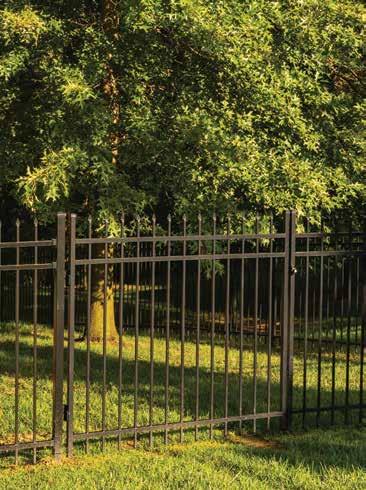

Agriculture plays a signi cant role in Missouri’s economy. Missouri is known for its diverse agricultural production, including crops such as corn, soybeans, wheat, and cotton, as well as livestock such as cattle, hogs, and poultry.

As the fth largest school district in Missouri, Columbia Public Schools is unique. e district is more than 300 square miles. It’s urban, suburban, and rural. ere is no other district in Missouri that has this same unique makeup of every type of school district all in one. It’s also what makes us special. ere is something for everyone.
Depending on your view of our community, when you think of Columbia Public Schools your rst thought might not be the learning opportunities o ered in agriculture for our scholars. Nevertheless, those important connections and opportunities do exist.
Opportunities to learn about agriculture begin as early as preschool in CPS and continue through high school and workforce development options for our scholars.
Connections begin with lessons on outdoor gardens, nature, food sources and systems, nutrition, and placebased learning activities. ey continue through eld trips, experiential learning opportunities, lessons on conservation, and more. For example, this past spring Two Mile Prairie Elementary School hosted Ag Day in partnership with the Missouri Department of Conversation and our Future Farmers of America (FFA) chapter. Students were able to learn about sh and wildlife from experts, see farm equipment up close, and learn about farming and animal science directly from our high school scholars
studying agriculture, who brought cows, horses, sheep, and goats to the school.
Additionally, Columbia Public Schools has Partners in Education that bring a wealth of knowledge to our schools, including the Center for Urban Agriculture and the Missouri Agriculture Experiment Stations through the University of Missouri College of Agriculture, Food and Natural Resources (CAFNR). MFA, 4-H, and Sydenstricker also provide important connections for our scholars.
Further, the district has invested in STEM and STEAM-focused programming at Benton Elementary School and Je erson Middle School. Fairview Elementary School o ers place-based learning programming.
When students reach high school, they have even greater access to courses, clubs, and activities. e district o ers courses in both agriculture and natural resources, including agriculture science, animal science, veterinary science, plant science, greenhouse production, agricultural mechanics, horticulture, agricultural business, and natural resources and wildlife conservation among others.
Our career and technical student organizations are second to none. Just this past school year, the Columbia FFA chapter boasted nine state champion-
ship wins at the state FFA competition. And Columbia Public Schools scholar Sam Tummons was elected to be the 2023-2024 Missouri FFA president.
rough relationships with area organizations and businesses such as MFA, 4-H, Sydenstricker, and more, students can pursue job shadowing and internships. Additionally, scholars can earn dual college credit for much of their coursework in the areas of agriculture and natural resources before they graduate high school.
Our scholars go on to pursue post-secondary learning opportunities and careers in agriculture with a strong basis provided to them through our enrichment opportunities, courses, and programs.
As the world and community continue to grow and change, agriculture will remain a crucial part of our lives, and Columbia Public Schools is committed to continuing its investment in agriculture education for our scholars.
 BY LAUREN SABLE FREIMAN | PHOTOS BY ANTHONY JINSON
BY LAUREN SABLE FREIMAN | PHOTOS BY ANTHONY JINSON
In 80,000 square feet of space, across four greenhouse facilities on the campus of the University of Missouri, undergraduate students are involved in hands-on learning, while graduate students and research students are conducting a vast variety of studies and experiments.
“ e greenhouses are utilized by multiple departments on campus in addition to Plant Sciences,” says Michelle Brooks, plant growth facility coordinator for the College of Agriculture, Food and Natural Resources (CAFNR) greenhouses at MU. “Approximately 90 percent of the space is used for research purposes and 10 percent is used for teaching purposes.”
All of the greenhouses are located on the main campus, with the East Campus Growth Facility and the Ashland Road Research Greenhouses on the southeast corner of campus; the Ernie and Lotti Sears Plant Growth Facility in the middle of campus; and the Bond Life Sciences Greenhouse on the roof of the Bond Life Sciences Center.
While several plant science classes include a lab that would bring undergraduate students into one of MU’s greenhouses, there are many other classes that also use the greenhouses. Brooks says that there are about 200 students each semester who use the greenhouse space for a class, in addition to about 50 principal investigators, plus the technicians, graduate students, and post-doctorate students who assist them.
Brooks o ers a Worker Protection Standards training each year for anyone who has access to greenhouse space, training about 500 people every year, she says, “so there are a lot of people on campus who use greenhouse space.”
ose who study weed science and turf management participate in labs inside the greenhouses, along with students in many other classes around campus.
In a greenhouse management class, students learn about greenhouse safety, building maintenance, pest management, and some plant production, while students in a plant propagation class learn various propagation techniques, both from seed and from vegetative cuttings, Brooks says. In the greenhouse, students will conduct a range of experiments on the plants they’ve propagated, from rooting hormone experiments to experimenting with di erent potting media.
In a greenhouse crops production class, which is focused on plants, ornamentals, hanging baskets, and vegetable and herb transplants, students learn commercial crop production by learning to grow plants from
start to nish. ey also have an opportunity to sell their plants in an on-campus plant shop called Tiger Garden. e money raised goes towards materials for the following year.
Environmental horticulture, an entry-level class that attracts students from all majors, as well as plant science students, also includes a lab in the greenhouse, allowing students to grow plants and plant vegetable gardens.
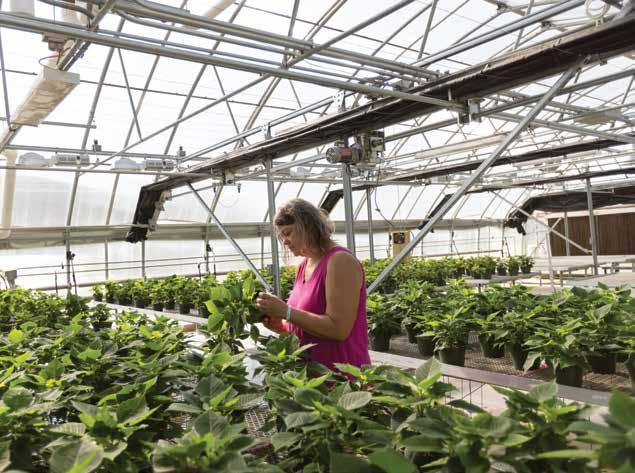
“Students have the opportunity to come out to the greenhouse to work with plants directly, hands-on,” Brooks says. “It solidi es what they are learning in the classroom. We are proponents of hands-on learning in CAFNR, of getting out of the classroom and into a greenhouse, getting their hands dirty, and learning by doing.”
Inside the East Campus Growth Facility are 24 greenhouse rooms. Two of those rooms are extended height units, in which plants up to 25 feet tall can be grown.
“We have the opportunity to do tree research or grow tall biofuel grasses when we get those projects started,” Brooks
says. “We can do research on full-size mature corn in an extended height growth chamber where we have precise control over the conditions, and that is unique to our location.”
Brooks says a phenotyping system will be installed within the next couple of years, providing an automated data collection process that uses lasers to measure things like tissue volume and plant growth.
While there are a wide variety of research projects underway at any given time, Brooks says the projects are mostly centered around agronomic crops like corn, soybeans, and wheat.
As the professional tasked with facility maintenance, Brooks says pest management is her biggest and most time-consuming challenge.
“Greenhouses are a great place for plants to grow, but also have ideal conditions for pests to develop,” she says. “It’s a constant battle — the number one hardest part of the job that takes up the most time.”
With so much space and so many species of plants on which to control pests,

Brooks says she uses an integrated pest management program to keep pests under control while minimizing the use of chemicals.
“We can’t avoid chemicals completely, but we rely heavily on physical and cultural controls as well as biological controls,” she adds.
Biological control means using living organisms to control a pest organism, rather than using a chemical. One biological control is releasing predators, like parasitoids, into the environment to naturally control pests. For aphids, that parasitoid is a tiny wasp that will lay an egg in the aphid. As the wasp develops, it kills the aphid.
“We also use types of fungi,” Brooks says. “We spray the fungal spores on the plant and the spores infect the pests and reduces pest levels.”

Because there are so many rooms of plants throughout the four greenhouses, Brooks says she relies on those using the space to notify her of pest problems. She then scouts the space, con rms the pest problem, and selects the best control to remedy the issue.

“I continue to monitor the population to make sure what we are doing is working,” she explains, “and I send noti cations if we are doing some control method so the people using the space aren’t doing something to counteract that control. Coordination is a key factor.”
Although MU’s four greenhouse facilities are not open to the public, and the research facilities have restricted entry to protect the integrity of the research projects, Brooks says tours are available for students, local garden clubs, and other groups by request. Students who are considering a major in plant sciences are also encouraged to set up a tour.
e greenhouses are also a great place for students to get an on-campus, part-time job, Brooks says.
“I have four or ve students who work for me each semester, plus the principal investigators generally have undergrads who work for them,” she notes. “It’s a great on-campus job opportunity where students can get more hands-on experience with plants.”



“We are proponents of hands-on learning in CAFNR, of getting out of the classroom and into a greenhouse, getting their hands dirty, and learning by doing.”
— MICHELLE BROOKS












 SHAUN HENRY ATKINS
SHAUN HENRY ATKINS
As the Dog Days of summer slowly slip away and summer enters its final muggy month, most families find their thoughts racing toward back-to-school excitement and the colorful months ahead. It can also be a bittersweet time as collegeage kids leave home, possibly getting their first apartment to leave an empty nest for Mom and Dad.
What better way to handle the possible empty-nest doldrums than by deciding how to fill or rearrange that empty space. You’ve already gotten off to a solid start if you’ve sent the college-age crowd off with some of your older furniture pieces for their own apartments and living spaces.
Now it’s time to think about … yourself. We’ve put together a sort of checklist –choose some or choose all – for taking on that empty-nest feeling.
• Don’t be so practical. With kids at home, it’s understandable you would value function over style for fear of spills or everyday wear and tear. But consider your empty nest an excuse to invest in that statement piece you’ve always wanted. Splurge on those long-coveted fabrics or rugs that you’ve shied away from in the name of practicality.
• Less is more sometimes. In fact, a coat of white paint could be just the change to help reinvigorate your space and layering in pieces — a white sofa or a light-colored rug — immediately creates a more modern look.
• Always wanted a library or home gym? Art room or game room? Make it a place to pursue me-time. No need to let your kids’ bedrooms sit empty. Converting them into the space you’ve always dreamed of could be a good way to help


Jake essentially grew up in the furniture industry, as he is the fourth generation involved in Baumgartner’s Furniture. Working very closely with his father, Alan, Jake has been devoted to the stores full-time since 2004. His greatest enjoyment, however, still comes from working closely with the customers. He is married to Sarah, and they have two active boys, Noah and Laine. Jake received his degree in finance from Saint Louis University.
(573) 256-6288
BAUMGARTNERS.COM

ease your transition into empty nest mode.
• At last, a space for guests. Substitute a twin bed for a queen or replace the old bed with a sofa bed and turn the bedroom into an office/ den area. It can still function as a snazzy guest room for visiting family and friends.
• Consider converting an unused guest room into your home office, with a daybed or futon for when guests stay over.
• Whether it’s a fresh coat of paint or simply updating your linens, small changes can go a long way in giving your space a fresh look. New pillows for that bare sofa? Great idea!
• Think smaller again. When your kids move out, that large-scale seating area will look even larger. It was perfect when there was an entire kid’s soccer team or a posse getting ready for high school prom, but now it’s time to look at a more customized and cozy seating area. One solution: Revise to one smaller sofa and two chic and comfy lounge chairs.
• Be imaginative, convert unused spaces into new areas for playing or work. Look for places that have never experienced home decorating – maybe those forgotten corners of the basement or even the laundry room. These can become comfy reading nooks.
You have so many possibilities now — with your home décor and your life. It’s time for experimentation … and change. You’re going to love your new empty nest home, and the possibilities will only increase once your creativity kicks in.
Your friends at Baumgartner’s are ready to help you navigate all of life’s transitions. We’re eager to know which empty-nest upgrades you’re seeking to make.
 By Kelly McBride Find more at rostlandscaping.com
By Kelly McBride Find more at rostlandscaping.com
Did you know: The leading cause of plant death in new landscapes isn’t pests or disease. It’s overwatering or underwatering plants, which, by the way, have very similar symptoms including: leaves wilting or dropping, changing colors, or needles turning brown. So, let’s talk proper watering so you can offer your plants the best chance at survival.
All new plants require routine watering for at least the first year while the roots get established. All the tips we outline below will vary a little bit based on the size of the plant purchased, soil drainage, temperatures, and rainfall. If it rains more than 1 inch that week, you can skip your scheduled watering.
Of course, the easiest way to water would be to have an irrigation system installed. Our sister company, Superior Irrigation, can program your controller to water your new plants properly with no hassle on your part.
If watering by hand, planting in spring and fall is preferred. The cooler temperatures and additional rainfall will reduce transplant shock, and the amount of time you have to water (unless of course, you decided to plant something in spring of 2023). Also, when planting be sure to pick a location that has easy access to water. Large trees need at least one 5-gallon bucket of water per 1 inch caliper a week. Each new container shrub will need at least one gallon of water each week.
There are a few methods you can consider using once a week if not enough rain was received:
• An easy way to make sure your trees get a slow, deep saturation is to buy gator bags, which we have here at Superior Garden Center. Gator bags can be filled in about
KELLY M c BRIDE ROST LANDSCAPINGKelly McBride grew up in Columbia just down the road from Rost Inc., and she's happy to still call Columbia home. She has a degree in plant science and landscape design from MU and was hired as Rost’s landscape maintenance manager after graduation. Her love for plants makes this job very enjoyable when assisting clients with their outdoor tasks. Outside of work, you can find her cooking, gardening, sewing, or doing other outdoor activities.

(573)
three minutes and can slowly release water over three hours. Unfortunately, these generally aren’t a viable option for shrubs as they are too small.
• Set a hose around the roots of the plant on a low drip and set a timer. Leave the hose running for 30 minutes per tree, 15 minutes per shrub, and move to other plants as necessary.
• We’ve also had customers in the past literally poke holes in their 5-gallon buckets, fill them up, and let them slowly release the water around the plant.
Sod
New sod is especially picky when it comes to water, and the first two weeks after installation is crucial! We would strongly suggest getting irrigation installed along with new sod. With irrigation, it can be put down any time of the year. Also, it will need to be watered thoroughly within the first couple hours of being laid. Then, it will need water a couple times a day for the first two weeks. If you don’t have irrigation, you’ll really have to babysit it consistently with a sprinkler.
If you enjoy planting flowers in pots on your porch or deck, keep in mind that the larger the container, the less frequently you’ll have to water. There is more soil in a larger container which the roots can pull moisture from. In the hot months they’ll need to be watered every other day. Some smaller containers will need to be watered daily. You’ll know you have a fully saturated pot when the water comes out the bottom hole.
Moral of the story here? The key to watering properly is to do so consistently and deeply, without going overboard.
Feel free to reach out to Superior Garden Center if questions arise as you water or contact Superior Irrigation to learn more about irrigation system installation and WIFI controllers.
445-4465 ROSTLANDSCAPING.COMThe pool isn’t just a handy place to be this summer. It’s a MUST place to be if you dare venture out for long. Missouri’s mid- to late-summer heat and humidity is always stifling, but what we’re experiencing now is on a level that weather forecasters say we’ve never seen. How are you staying cool? And we’re betting that outdoor maintenance, other than mowing after a rare rain shower, is just about the last thing on your mind. But here’s why thinking about home maintenance – both inside and out – is an important topic Simply put, identifying and tending to home maintenance needs now (or as soon as there’s at least a brief respite from this heat) will make painting less challenging and more affordable when the time comes to spruce up or freshen up your home’s colors.
Painting your home or commercial building is not a one-time investment. To keep it looking good, here are some important maintenance tips.
Exterior
• Keep your exterior washed by getting it power washed each year. With a pressure washer, take care not to exceed the manufacturer’s PSI for the substrate you are washing.
• Every year or two, use a sponge or softbristled brush to lightly scrub away any stuck-on debris, then use a hose to rinse.
• Keep your gutters cleaned out.
• Caulk around your windows and doors.
• Keep clutter off the substrate of your home to help prevent mildew build up and rot.
• Keep trees pruned around your home. Trees or bushes rubbing or resting on
Jaclyn Rogers, sales representative at Ai Painting Plus, sees paint as more valuable than simply being an accent in a home. “We are painting joy into people’s homes,” she says. Jaclyn is certified as a Psychological Color Expert, which means she has demonstrated mastery in specifying interior paint in residential applications.

your home will cause damage to paint and siding; so will any other plantings or fallen leaves that rest against your home. These are often missed culprits that hold moisture against your home and cause moisture damage.
• Water your foundation to help prevent settling.
• Check the condition of decks and fences. Sealed or painted decks and fences fail much quicker than homes and typically need redoing every one to three years.
• From choosing the right product for each room to scheduling regular touchups, following these steps will help make sure your interior paint job also stands the test of time. Here are some tips for maintaining beautiful walls without spending on a new coat of paint every season.
• Keep the bathroom fan running while taking a shower.
• Make sure doorstops are installed to prevent doorknob holes in the walls.
• Wash your walls regularly. Dust and dirt can build up, causing paint to look dull and fade. (Try to dust or even vacuum your
walls every week or two, or more frequently if you have young children or pets.)
• Use mild soap and water to avoid damaging the paint. You can purchase wall-washing solutions or make your own by mixing ¼ cup of white vinegar with 1 gallon of water. Absolutely avoid using harsh chemicals such as bleach, ammonia, and oven cleaner. (Yeah, there are some wall-cleaning horror stories!)
• Touch up scuffs and scratches immediately.
• Don’t hesitate to repaint.
Remember: Repainting is a great way to freshen up the look of your home or office building without having to do a complete renovation. And if you’ve been on the fence for a while about repainting because you’re not convinced the wall color and trim color match the way you’d like, a repainting project could be just the thing you need to have peace of mind — and a more eyepopping space.
If you need further information on the importance of exterior and interior maintenance, or if the time has come to paint and you prefer to hand-off that task, trust the experienced team at Ai Painting Plus to be there for you.

I’m no farmer, but Paul Harvey’s “So God Made a Farmer” speech always inspired me, helped shape my respect for farmers, and possibly planted the seed that led to my desire to do the work I do. I don’t recall the first time I heard it, but I do remember sitting quietly, listening to his familiar voice pay tribute to an underappreciated group. Farmers work a lot harder than those not on the farm realize. From season to season, they continue to work hard to keep the world fed. Impressive. With lawn care, tree and shrub care, landscaping, and irrigation, there are several sound agricultural principles that we use every day to improve on our surroundings and help our customers manage their property. Many are just based on good stewardship, and positively impact our environment to ensure a healthy future for everyone. Here are some sound practices for the groundskeeper:
• We promote the installation and proper use of an in-ground sprinkler system. Having an understanding of what water needs you have within your lawn and landscape will help to ensure that each area is getting the proper amount of water and you minimize waste.

• Water deep and less often is typically good advice. Smart controllers can adjust the watering schedule based on real-time soil conditions, weather, evaporation rates, and specific plant water use. Now that’s smart!
• An in-ground irrigation system will provide better coverage of the lawn and landscape than any garden hose end setup.
• Another reason to get to know the lawn and landscape plants on your property is to learn what nutritional needs they have. Haphazardly throwing fertilizer around that you found in the shed isn’t the best plan.
A Columbia native, Shaun Henry found a home at Atkins in 2000 when he started his career as a turf technician. Shaun holds a commercial applicator’s license through the Missouri Department of Agriculture and is a member of the National Association of Landscape Professionals, the Mid-America Green Industry Council, and the Missouri Green Industry Alliance. Shaun strongly believes in the importance of a great customer experience where the Atkins staff knows their clients and anticipates their needs accordingly.
Shaun is an MU alumnus and has a degree in plant science.
573-874-5100
Soil testing, weather forecast watching, experience from one season to the next, and familiarity with your plants and their needs can all help you choose the right materials, timing, and method.
• Nitrogen is typically the first nutrient to consider when making your plans and there are a large number of nitrogen sources to consider. Phosphorus and Potassium (aka potash) are the other two macro-nutrients found in most fertilizers.
• Not all dirt is the same. Soil is comprised of minerals, organic matter, air, and water. With a soil test, you can get a better understanding of the soil texture and chemical makeup. It may actually reveal that you don’t need to fertilize or at least not as much as you think. You may have a pH issue needing correction. If acidic, applying lime will actually help make existing soil nutrients become plant available.
• You may need “secondary” or micronutrients (calcium, magnesium, sulfur, boron, copper, iron, manganese, etc.) and more organic matter to improve your soil and overall plant health.
• Make sure when you seed or install some new landscaping that you’re choosing the right plant for the right place. Timing and care afterward also need to be considered.
• All crops have pest issues. From insects to diseases to weeds, they all have pressure from outside sources. Best management practices for your crop include setting tolerance levels and goals, diagnosing problems, proper care of specific plants, managing water needs, fertility, planting, and maintenance practices. When you’re not sure what’s going on with your lawn or your trees and shrubs, you can call on a professional to draw from their experience and training to be sure you correctly diagnose the issue and prescribe the best course of action to manage it.
Now is the time to make plans for seeding and replacing those dying or dead trees and shrubs. The end of August kicks off the fall season for lawns and landscapes as the weather tends to become more forgiving. If you need help with anything around your property, inside or out, don’t hesitate to call Atkins. We’re here to help. It’s what we do!

The journey from farm to table is more than a passion for Walker Claridge: it is a deeply rooted commitment that has seeped into all aspects of his life.
From his farm in Hatton — Terra Bella — where he grows sustainable, specialty crops to his restaurant in downtown Columbia — Broadway Brewery — Claridge focuses on the ultimate goal of making local food more accessible to the community while supporting its farms and farmers. Claridge began farming in his mid-20s, selling his harvest at local farmers markets across mid-Missouri and to rising chefs from Kansas City to St. Louis, including James Beard award-winners like Kevin Nash and Girard Craft. In doing so, he noticed that local farmers’ products were widely unavailable in grocery stores and thus inaccessible to the general public. As a solution, Claridge opened e Root Cellar in 2001, the rst grocery store of its kind in Columbia. Working to support both new and seasoned farmers, e Root Cellar o ered only local family-farmed food to customers including produce, meats, dairy, and products made from ingredients bought directly from more than 140 Missouri farmers.

“ e sauces, jams, and other products we sold were made from those same ingredients and all of the produce was at the height of freshness, delivered right after it has been picked,” Claridge explains. “ e meats came from non-conned farms that were both antibiotic and hormone free.”
rough e Root Cellar, Claridge began supplying Columbia restaurants such as Trattoria Strada Nova, Cherry Street Wine Cellar, Sycamore, and Uprise Bakery with products from local farms. He then took what he calls “the next logical step” in shifting from supplying to opening his own farm-to-table restaurant, Broadway Brewery, in 2009.
“Broadway Brewery was just an extension of all those activities that I was already involved in,” Claridge says. “Plus, it was a way to marry beer production with food production — two of my big passions — while making that vital connection from the chef to the farmers.”

Claridge has since continued to establish a supply chain for local foods. He grows food at Terra Bella Farms mostly for Broadway Brewery, but often sells what’s left over to other restaurants. He says he’s always glad to pass on the names of other local producers to try and increase their business and make connections with other restaurants.

“It has been an interesting journey for me,” he continues. “I feel so fortunate to be a part of that history and to be intimately involved with creating that process.”
As expected, nearly every dish o ered at Broadway Brewery is studded with locally sourced products and ingredients, which are detailed in the food descriptions and Missouri map on the printed version of the menu.
e restaurant’s menu undergoes a complete overhaul three times a year, keeping the customer favorites while adding in new, seasonal dishes.

“This deeply personal connection to food allows me to enjoy it that much more. I am always working to take this vision of local, sustainable food and integrate it into this restaurant and my way of life. Each time I’m successful, it makes me want to do it more. If I didn’t have these reasons, I would get out of the business.”
 - Walker Claridge
- Walker Claridge
Claridge says, “When making menu changes, we are rst looking at ingredients we can feature from local farmers, and then how we can satisfy our clientele’s ever-changing taste buds.”
Sharing plates on the current menu include fried cheese curds made using cheese from Hemme Brothers in Sweet Springs and Blue Heron sriracha wings with chicken from Buttonwood Farms in California, the only local wings regularly o ered in Columbia, he says.

e pork used by Broadway Brewery comes from Patchwork Family Farms in Columbia, a project of the Missouri Rural Crisis Center including the Patchwork pork chop, pulled pork, and baby back ribs.

Claridge says that not only are all the ingredients local, but the chefs are making almost everything they can from scratch including curing their own bacon, pastramis, and sausages.
Shawn’s BLT pizza is topped with house bacon lardons, cheddar from Milton Creamery in Iowa, arugula, heirloom tomatoes, and tomato aioli. e meat lover’s pizza is topped with pepperoni from Volpi in St. Louis.

“Anything we can do to take a local product and feature it on the plate. e freshness of the avors stands out and people taste it and are amazed,” Claridge explains.
Every three weeks a whole steer from Neuner Farm in Westphalia is processed and the resulting cuts are rotated on the menu from strip to let to sirloin to ribeye. Claridge says the goal is to use all parts of the animal, including the tongue used in the surprisingly popular beef tongue tacos. e tongues are cured in a pink salt for 24 to 48 hours, “which is kind of like brining,” he adds, then simmered for six to seven hours in beef stock. After that the meat is shredded, seasoned, and served
like taco meat on a corn tortilla with cilantro, radish, and a sauce.
Recently, Broadway Brewery chefs, Chris Pender and Grant Williamson — a recent Culinary Institute of America graduate — have been working to create inventive yet delicious pescetarian, vegetarian, vegan, and gluten-free options. Claridge says they are always asking themselves, “How do I make a dish that is so good customers don’t care if it is vegetarian or not?”

“Our customer base knows we keep dietary considerations in mind,” he notes. “It’s a fty- fty split between people that come for those special options and those who are just coming to get really good food.”
e vegetarian chicken and wa es feature a lion’s mane mushroom heart from Ozark Forest Mushrooms, battered and fried on top of a crispy cheddar cheese rice wa e with creamed greens and lemon ricotta, and rosemary agave syrup.
Other purveyors and products used by Broadway Brewery include River Hills Harvest elderberries, Sparky’s Ice Cream, Goldie’s Bagels, Uprise Bakery breads, Camacho co ee, and Terrell Creek Farm goat cheese.
Claridge explains the immense bene ts of supporting mid-Missouri farmers.
“Not only is the produce quality vastly superior, but buying local supports independent families in the area who are using sustainable lands to prevent urban sprawl. It keeps dollars circulating in the community ... It’s important to always be sure that your values as a business line up with the values of the producers.”
For his next steps, Claridge says he is always considering what’s the most important for his restaurant and his community. He recently opened Broadway on 9th, a taproom and private event space featuring 14 house drafts, a full bar, and a 16-foot garage door open to the sidewalk.
“ is deeply personal connection to food allows me to enjoy it that much more,” he explains, emphasizing that he’s always working to take the vision of local, sustainable food “and integrate it into this restaurant and my way of life.”
Claridge adds, “Each time I’m successful, it makes me want to do it more. If I didn’t have these reasons, I would get out of the business.”
If you’ve ever spoken to friends about wanting to start a garden, it’s likely they have told you to visit one place above all others: Strawberry Hill Farms.
With 28 buildings spread out over two acres, the farm o ers a bevy of herbs, owers, shrubs, tropicals, and houseplants. It’s a massive operation, but Strawberry Hill Farms is in a league of its own because nearly all of its plants are grown onsite.
“We’ve grown about 90 percent of what we sell,” says owner Steven Sapp. “We just grow what we think people will want.”
One of the largest retail greenhouses in the state, Strawberry Hill Farms still manages to sell out its inventory every season. e farm is closed in summer and winter, which gives employees plenty of time to grow the next season’s batch of weather-appropriate plants.

ese days, Strawberry Hill Farms is an expansive hotspot for gardening enthusiasts, but the family farm had humble beginnings.
Strawberry Hill Farms was originally founded in 1980 by Sapp’s parents, who had been raising and selling vegetables as a side business.
“My parents started this operation with one little greenhouse,” Sapp says. “My mom was a school teacher, so she would bring home those little cardboard milk cartons from school, cut the tops o them, then they would plant tomatoes in them.” roughout the 1980s, the farm began to expand, prompting Sapp’s parents to quit their jobs and pursue farming as a full-time endeavor. ey planted a straw-
berry eld, allowing customers to pick their own berries. ough the farm no longer o ers pick-your-own strawberries, the name Strawberry Hill stuck.
“I worked in the business since I was a kid and helped raise a lot of vegetables,” Sapp remembers, explaining that his childhood inspired him to go into the family business. “I ended up going to MU and got a degree in agricultural systems management, then when I came back from college I started working [at Strawberry Hill Farms] full time. My focus was to try to build the business bigger and supply more variety and volume.”
In 2011, Steven and his wife, Amy, ofcially purchased Strawberry Hill Farms from his parents. Since then, the Sapps have worked side-by-side to make their business a success.
“It’s not always easy, but we get along great. We like working together,” Sapp says. “We each have our strengths, but we’re both available for whatever might happen. ere’s some not-so-glamorous things, but we’re not afraid to do all the dirty work. You gotta be willing to do all the facets of the job.”
Families at the Farm
Strawberry Hill Farms has expanded far past the immediate Sapp family, as the operation requires a signi cant amount of labor to run smoothly.

“We take a lot of pride in taking care of the products we grow, so the majority of everything that’s grown, we water by hand,” Sapp says. “We’re not automated on everything, so it’s a lot of labor-intensive practice. In the end, I think it’s well worth it, because it shows in our products.”
is hard work is evident in all of Strawberry Hill’s o erings but shines in its vegetable plants, which are among the farm’s most popular products. ough they aren’t the most pro table crop — smaller vegetable plants are sold for $2.49 — Sapp explains that it’s important to him that customers can buy healthy starting plants at reasonable prices as a way to help economically feed their families.
at’s a mission that is shared by many of Strawberry Hill’s employees, as Sapp continues: “We’ve been really blessed with a lot of good people over the years. It’s seasonal, so sometimes employees come and go, but there’s some that have been with us for over 20 years. When you see these people every day, it does become kind of a family.”
More than that, Strawberry Hill Farms has become a place where families can grow both plants and memories together. Sapp describes seeing multiple generations peruse the farm, enjoying the greenery together.
“We try to provide a good family atmosphere, and parents, children, grandchildren all come together,” he says. “I constantly run into people who say, ‘I used to bring my grandmother down there and we would spend hours looking at the plants’ or ‘I came there this spring with my mother and kids,’ so [coming to Strawberry Hill] is kind of a family outing.”
Since its founding in 1980, Strawberry Hill Farms has become a staple in Colum-

bia and the surrounding communities, helping individuals and families cultivate gardens that are both functional and beautiful. Still, like any good business owners, they are always looking for ways to improve.

“For the last couple of years, we’ve been trying to improve our structures,” Steven says, explaining that they have been making changes to Strawberry Hill’s many greenhouses in order to make them more user and customer-friendly. “We’re almost to the point where we’re about as big of an operation as we can handle. Now, we’re just trying to make it more sustainable and easier on everybody involved.”
After more than 40 years in business, Strawberry Hill Farms shows no sign of slowing down, which is evidenced by Steven’s position on — and this might sound funny — gift card expiration dates.
“We sell gift certi cates, so a lot of times somebody will call and ask, ‘Oh, is this expired?’ and I say, ‘No, not until we do,’” he says with a laugh. “Hopefully, we’ll be able to do this for a long time, and maybe our kids will be interested in doing it in the future. It’s hard, but to see something that you’ve started, planted, grown, and taken care of yourself, then to see someone pick it up and want to grow it and care for it further … Seeing it to the end like that is so satisfying, and we’ve really appreciated all the people who have supported us over the years.”
STRAWBERRY HILL FARMS 3770 E. Highway 163 strawberryhillfarms.net 573-449-1631


Columbia’s manicured lawns look orderly and pristine. But if you want to create a buzz in your yard, you’ll need to take a walk on the wild side.
 BY MICHELLE TERHUNE
BY MICHELLE TERHUNE
Seventy- ve percent of the world’s owering plants rely on pollination to reproduce, and some 35 percent of plants we harvest for food — like vegetables, fruits, and nuts — rely on pollinators. Without all those bees buzzing around the apple trees when they’re in bloom, there won’t be any crisp apples to eat in the fall.
If you think propagating habitat for bees, butter ies, hummingbirds, ants, moths, wasps, ies, and beetles is a “rural” thing, think again. As residential and commercial development clears woods and elds and replaces them with asphalt and concrete, more and more pollinators are squeezed out.
Somewhere between foregoing development and saving pollinators lies a compromise: ere are opportunities to create wild spaces within.
Danielle Fox joined the city of Columbia in October 2016 in a partnership with the Missouri Department of Conservation. Not every city has a community conservationist, but Columbia’s wealth of parks, trails, forests, and streams o ers prime opportunities for conservation initiatives. You might have noticed places where natural habitats have replaced lawns, including 15 acres in parks and 29 acres along Columbia roadsides.
Most people associate the need to create habitat with the plight of the monarch butter y and European honeybees. But returning land to its natural habitat not only bene ts pollinators, insects, and birds, but water as well. Native plants don’t require watering as non-natives do. Plus, they’re natural cleansers.
“It’s not just about conserving water from the tap, but it’s also about ltering stormwater,” Fox says. “All the rain that comes o our roof and runs into our yard eventually ends up in a creek. So, if our yard can be the rst lter for that stormwater and remove some of the pollutants before it hits our local streams, that’s all the better.”
As Columbia continues to grow, the city can’t expand natural habitat on its own. Residents need to be involved in their own spaces as well. And they are.
Fox launched the CoMo Wild Yards program in 2017 to promote practices that improve the city’s biodiversity. Residents can learn how to convert some of their yards to natural habitats. If they already have it, they can have their wild yard certi ed.


“My original goal was to create a network of community members and engage them in conservation so we can build awareness about how our yards interact and a ect the larger environment around us,” Fox says. In 2019 the city council adopted its Climate Action and Adaptation Plan. Part of that plan on the adaptation side is building and improving biodiversity.
Fox adds, “ e more biodiverse your environment is, the more resilient it is to changes in our climate.”
Homeowners and business owners can schedule a site survey and consultation through Fox’s o ce and receive a plan for converting areas of their yards into natural habitats. It’s not a landscape design. e plan recommends native plants that will grow well in each person’s space.

Only 10 wild yards have been certi ed as silver, gold, or platinum to date. e di erence in levels is the variety of plants, shrubs, and trees used. Fox says the more complex it is, the more diverse it is — and that’s what she wants people to work toward.

About 150 plans have been developed so far and roughly 100 are active. at’s a lot of work for a single conservationist, which is why Fox has partnered with sta from the U.S. Fish and Wildlife Service Missouri Private Lands O ce to survey yards and develop plans.
“Historically, we’ve focused quite a bit of our work out in the rural landscapes,” says Erin Holmes, state coordinator for the Partners for Fish and Wildlife program. “But in recent years, we’ve started to focus on how we can create and maintain habitat within cityscapes and work within communities to help them identify resource concerns they may have about their immediate surroundings and how we can address that with nature-based solutions.”
is partnership bene ts the Wild Yards program beyond sta ng. e city and U.S. Fish and Wildlife are providing funding that will be used to help residents create native landscapes in yards. Fox says having the funding to buy plants makes the program more inclusive by putting it within reach for more homeowners.
“Most people get caught up on the fact that they have just a small area to work with,” Holmes says. “But one of the cool things about planting native gardens is that there’s an immediate response to that. Home-
“...the amount of butterflies I get to see each day does my heart good. Plus, the waves of colors I get to see from early spring until late fall are quite breathtaking.”
— RICK ROBERTSON
owners, even in a small yard, can have a positive impact on species.”
Rick Robertson is known around town as the owner of Booches, a Columbia institution. But he’s also known for his incredible pollinator yard.
Reading about declining populations of monarchs and bees two decades ago prompted Robertson to start thinking about what he could do to change that trajectory. After losing a lot of plants in the drought of 2012, he began slowly converting his yard to a native one. Today, about three-quarters of his yard is devoted to native plants.
“ ere are so many things that excite me about my yard,” Robertson says. “Each day, you can hear the sound of the bees doing their thing. And the amount of butter ies I get to see each day does my heart good. Plus, the waves of colors I get to see from early spring until late fall are quite breathtaking.”
Lottie Bushmann’s husband wanted to replace some of their yard with bu alo grass 15 years ago so he wouldn’t have to mow it all. But such plantings tended to violate city ordinances back then —something that’s changed in recent years.
Bushmann saw her rst cedar waxwing in the fall of 2003. She became hooked on birds and planting things that would attract them and butter ies. Her house is located at the bottom of Katy Lane on the MKT Trail where the adjacent cul de sac drains a lot of water into their yard.
“When we rst moved there, the backyard was honeysuckle and blackberries bordering a fescue lawn,” Buschmann says. “My husband had the brilliant idea to landscape with natives along the path of the water to the wetlands. It did help channel the water which kept it from being a mucky mess. He also removed all the honeysuckle.”
Bushmann chooses native plants

that can tolerate both wet feet and drought, as many native species do. Now, her yard is lled with birds, monarchs, zebra swallowtails, and other pollinators.
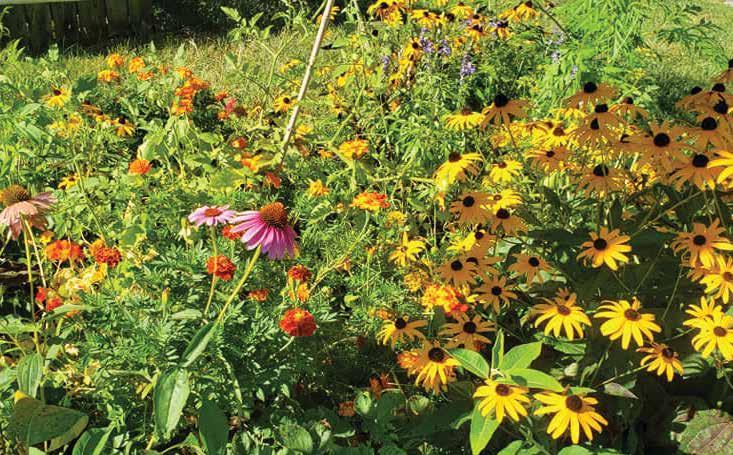
e relationship between birds and pollinators, and those who love them, is a close one. Allison Vaughn handles communications for the Columbia Audubon Society. When the owner of the daycare across the street from her home asked if she could plant some milkweed for them to attract monarch butter ies, Vaughn jumped right in. Now, the two small native wild ower beds at the daycare attract pollinators. Vaughn also digs and separates the native plants to distribute to neighborhood homeowners.
“ e kids and parents of all ages love the owers and seeing the butter ies and big bumblebees,” Vaughn says. “It's really important to introduce children to native plants and the importance of them on the landscape.”
en, there’s the Columbia Audubon Society’s Nature Sanctuary. It’s roughly 28 acres, nestled between Bray Avenue in a residential neighborhood and the city’s Bonnie View Nature Sanctuary. A decade after Bill Mees and other members received a grant from the Missouri Bird Conservation Initiative to restore the acreage to native grasslands, nearly 170 di erent species of birds have been spotted, along with butter ies, bees, and other pollinators.
“ e sanctuary’s presence on the edge of a subdivision helps educate people who otherwise probably wouldn’t go to an area like this,” Mees says. “But since it’s right out their back door, and since Scott’s Branch Trail runs along the southern edge of our property, there’s a lot of foot tra c, dog walkers, and bicyclers who all get to see it.”
While some people view native gardens as uncharacteristic of an urban landscape. But Fox is hopeful that e orts to restore pockets of natural habitat in Columbia will continue to grow.
“ e program has made people more con dent about speaking out when others who are vocal aren’t as favorable toward native landscapes,” Fox says. “People are nding their voice.”




You say “tomayto,” I say “tomahto,” but in reality, what di erence does it make? e important point is that these wonderful, locally grown red globes are available at the Columbia Farmers Market.
Whom do we have to thank for this juicy fruit? (Yes, botanically it is a fruit, as are eggplants, squash, and several other edible, grand plant species. “Vegetable” is merely a culinary term, so one would be correct to refer to a tomato as either.) Apparently, the indigenous people of Central and South America were the rst to cultivate the tomato, and it is native to those areas, as is its cousin the potato.
One of the few positive results of the Spanish conquest of the New World was the exportation of these plants to Europe and the rest of the world. At rst viewed with a little skepticism as to being edible, since they are a member of the Nightshade family, tomatoes were eventually embraced worldwide, and are now internationally popular.
In 2022, a staggering 125 million tons of tomatoes were produced worldwide, with China producing the most — three times the output of second-place India, with the United States coming in third. Turkey and Egypt rounded out the list of the top ve tomato producers.
But why do locally grown tomatoes taste so much better than those “store-bought” fruits? First and foremost, they are picked when ripe, generally the same day as you buy them. Commercial tomatoes are generally picked green, then ripened using natural ethylene gas to start the process. Of course, you could use them as a substitute for a baseball, if necessary.
e second reason locals are better is that the varieties grown are picked out more for taste than shipping ability, and the growers know that their reputation rides on the product. Like in most other endeavors, the farmers take pride in what they o er and strive to o er maximum quality.
So it’s at this time of year that I strive to use the fruits of the season as much as possible. I’ll make everything from fresh salsa cruda to marinara sauce and fresh tomato chili, which is well worth the e ort. But there is only so much that can be consumed in the relatively short window of time that we have to enjoy the local crop.
ere is, however, a way to maximize your enjoyment. Every time you want to make a batch of a recipe, make four times (or two times) as much, and freeze the extra in meal-size containers. at way, you can enjoy the avor of summer year-round. Or, make a large batch of stewed tomatoes, and freeze them by the quart, then retrieve what you need from the freezer through the winter. Either way, your palate will thank you for the e ort!
Jim

INGREDIENTS:
• 1 ½ lbs. coarsely ground or nely diced beef chuck



• 3 c. chopped yellow onion
• ½ c. chopped green chile
• 2 tbsp. minced garlic
• ¾ c. chili powder
• ½ tsp. salt
• 1 tsp. fresh ground black pepper
• 1 tbsp. whole cumin
• 1 tbsp. dried Mexican oregano
• A pinch of crushed red pepper
• 2 ½ lbs. diced peeled fresh local tomatoes
• 1 tsp. sugar (optional)
• 2 qts. rich beef stock
• 1 c. dried pinto beans
1. Rinse the pinto beans, add to boiling stock. Cook for 45 minutes.
2. Add tomatoes, onions, garlic, and spices, and simmer for an additional 30 minutes.
3. Meanwhile, brown beef in heavy bottom pot.
4. When browned, add stock mixture to beef, add green chiles, and simmer until beans are done, about 30 more minutes, adding water if needed.
5. Adjust seasoning and add sugar, if desired.
“Hoss” Koetting is a retired restaurateur/chef who enjoys gardening, good food, good bourbon, and good friends.
To peel tomatoes, drop them in boiling water for a few minutes until the skin starts to split, then remove, let cool, and the skin comes right off.
CHEF'S TIP:
When you think of Future Farmers of America (FFA), what comes to mind? Maybe the dark blue corduroy jackets featuring the FFA logo and gold embroidery. Perhaps you think of high school guys perpetually attired in blue jeans and cowboy boots, planning to take over the family farm.
While such perceptions may be accurate, they are only part of the organization’s storied picture. Athletes, entertainers, entrepreneurs, titans of business and industry, congresswomen and men, doctors, chemists, accountants, teachers, and, yes, farmers, ranchers, and more have their roots in FFA.
BY MICHELLE TERHUNEYou may not be surprised that FFA’s famous alumni include Tim McGraw and Willie Nelson. But how about Don Henley and Taylor Swift? Add to the list Bo Jackson, Olympic gold medalist pole vaulter Stacy Dragila, and Bu alo Bills quarterback Josh Allen, who was an FFA national nalist in 2014 for diversi ed crop production.
Future Farmers of America has bolted into the 21st century, taking young men and women for the ride of their lives. And not just on horses or tractors.
Bestselling author Ally Carter still lives near the farm she grew up on in Oklahoma. And FFA helped propel Anne Knapke from the 2003-04 FFA national vice president to deputy chief of sta for policy at the United States Department of Agriculture (USDA).
It’s easy to think that because farming is shrinking in mid-Missouri as towns and cities grow and spread, an ag-related high school student organization would become irrelevant. ink again. Growing numbers of high school students in Columbia and Hallsville are joining FFA. Perhaps that’s because it’s not just for farmers anymore.
In 1988, FFA changed its o cial name to the National FFA Organization. Although it wanted to hold onto its 1928 origins with the future farmers of the country, it also recognized that its trajectory was changing. According to the National FFA website:
“FFA continues to help the next generation rise up to meet those challenges by helping its members to develop their own unique talents and explore their interests in a broad range of agricultural career pathways. So today, we are still the Future Farmers of America. But, we are the future biologists, future chemists, future veterinarians, future engineers, and future entrepreneurs of America, too.”
Expanding the mission and focus of FFA helps the organization draw members from a deeper pool of prospects and continues to keep it relevant in the 21st century.

According to the Missouri Department of Agriculture, there are 95,000 farms in Missouri, mostly family owned and operated. But in 1950, there were about a quarter of a million farms in the Show-Me State. Agriculture has changed, broadening its scope from just production farming and ranching, and so has FFA.
Kevin Duncan is the Columbia Area Career Center lead FFA adviser for the Columbia Chapter, one of six FFA advisers and ag instructors for Columbia Public Schools.
“ e FFA has broadened its focus into all areas of agriculture from research to production, rural to urban, and everything in between,” Duncan says.
Today, Missouri FFA reports 355 chapters and nearly 26,000 members, the eighth largest membership in the country. Missouri FFA divides chapters among six districts. e Columbia and Hallsville chapters are both in the Northeast District.
Most chapters are speci c to a single high school, such as the Hallsville chapter. But the Columbia chapter is di erent, encompassing all three public high schools under the tent of the Columbia Area Career Center (CACC). Battle, Hickman, and Rock Bridge students operate under that single umbrella, along with a
smattering of other students who attend CACC, including some from private and parochial high schools as well as homeschooled students.
“I think a lot of people are surprised that Columbia has an active FFA program, but it just goes with the broad view of agriculture that it makes sense. Production, processing, marketing, research and development, [and] distribution in all areas of agriculture take place in and around Columbia,” Duncan says.
Despite the broader reach of today’s FFA chapters, its membership continues to re ect a rural versus urban divide when looking at per-capita numbers. Columbia FFA’s membership is roughly 100.
Caleb Martin, agriculture education instructor and FFA adviser at Hallsville High School, says membership there averages 160 students or about a quarter of its student body. at said, there’s no
“FFA is still grounded in the roots of agriculture, but it is so much more than it was just a decade ago.”
— KEVIN DUNCANColumbia FFA members Sadie Tummons, Madison Pulliam and Hayden Duncan, and FFA adviser Kevin Duncan, visit Missouri 3rd District Congressional Representative Blaine Luetkemeyer during the national organization’s Washington Leadership Conference in June 2023.
dividing line within the organization. Every student is o ered an opportunity to lead and succeed.
“Students learn and develop skills in FFA that will last them a lifetime,” Martin says. “Students will learn interviewing skills, leadership skills, and career skills. ey will take everything that they have learned and become successful in all phases of life.”
Sydney Schupp Winn is a shining example of what can happen to a city-raised student who nds her way into FFA. Without a doubt, farming is in her DNA. Her grandparents farm more than 1,000 acres in Cooper County. Her interest led her to take an introduction to agriculture class as a freshman at Battle. Later, she was asked to join the FFA Knowledge Team. at’s a team of students who compete on a 100-question test about the history and mission of FFA. Winn joined the team and Columbia FFA.
“FFA is for everyone, as it teaches more than what high school alone can teach,” Winn says. “And just because someone doesn’t come from an agriculture background doesn’t mean there isn’t a place for you within the organization.”
Two key components of FFA are school-based agricultural education and supervised agricultural experiences (SAEs). SAEs are personalized experiences designed to help students explore career options and develop skills that will help them achieve their goals.

Sydney Schupp Winn left FFA at Battle High School bound for a biology degree at Truman State University. Instead, she earned a degree in ag science and now works for Missouri Farm Bureau.

“And just because someone doesn’t come from an agriculture background doesn’t mean there isn’t a place for you within the organization.”Schupp Farms
— SYDNEY SCHUPP WINN
Winn’s SAE involved renting 70 acres of cropland from her grandparents’ farm for three years, where she rotated planting soybeans and corn. Schupp Farms is a Missouri Century Farm, owned and operated continuously by the family for more than 100 years. For Winn, the experience was much more than exploring her family’s agricultural roots. Not only did she learn about hands-on farming, but she also learned the business as well.
“FFA gives students access to hands-on learning opportunities that are not o ered elsewhere,” Winn says. “I would encourage everyone to try out an agriculture class and join FFA.”


Winn graduated from Battle in 2018 and headed to Truman State University to major in biology. She soon gured out that being conned to a lab wasn’t for her. In 2022, Winn graduated with a bachelor’s degree in agricultural science with an emphasis in ag business. Today, she’s a legislative specialist with Missouri Farm Bureau, working with the organization’s directors of national, state, and regulatory legislative a airs, which points to another change in FFA: It hasn’t been just for boys for a very long time.
“FFA gives everyone the same opportunities to explore and learn, regardless of gender,” Winn says. “FFA gives young women the opportunity to learn in an open-minded environment about a typically male-dominated industry. is then gives young women the con dence to succeed in the agriculture industry.”
FFA activities are both competitive and non-competitive. ey occur at the local, state, and national levels. ere are school and district events, the Boone County Fair, National FFA Week, and the Missouri and national conventions. Students succeed as groups and as individuals.

For example, Columbia FFA has three career development event teams representing CPS and Missouri FFA at the National FFA Convention in November. And Hallsville’s Roselynn Orr received a grant from the Missouri FFA Foundation to assist with her ag-related entrepreneurial goals. Orr is developing two equine-related apps, EqueTrainer and GiddeeUP. She’s just a senior in high school this year.
Who would have thought FFA would become an organization that teaches the skills necessary to succeed in virtually any type of career or support a young woman developing an app?
“ is organization has changed a bunch over the years. We are so diversi ed in all the di erent aspects of agriculture from the technology side to leadership and career building,” Martin says. “We want to make sure that we include everyone and make sure our students have a purpose in the future of agriculture.”
Duncan agrees.
“FFA is still grounded in the roots of agriculture,” he says. “But it is so much more than it was just a decade ago.”

ifyou live in Columbia and have never been to the Columbia Farmers Market, what are you waiting for?
CFM, in the middle of Columbia’s Agriculture Park, is one of the city’s crown jewels. Nestled in 20 acres adjacent to the 73,000-square-foot Activity and Recreation Center at 1701 W. Ash St., you can shop from local farmers who are selling everything from fresh owers, produce, and meats to honey, jams, artisan breads, and even bath products.
e local farmers market is a main attraction year-round, but especially at the Saturday Market during the summer, where there’s something for everyone — a playground and activities for the kids, live music, educational workshops, and food trucks. e Saturday Market enjoys a festive vibe, thanks in part to the eye-popping attendance, which topped 6,000 several times in 2022, says CFM Executive Director Corrina Smith, who has been at CFM’s helm since 2013.
“So there are 98 stalls here,” Smith explains, describing the scope of the sprawling, covered market structure, of which the center third — the MU Health Care Pavilion — is the only completed portion as of July 2023. Two long wings of steel structure on either side await their roof.
Forty of the stalls are under the MU Health Care Pavilion, which was completed in 2019.
“ is was always the plan — we were always going to put all 98 under [a covered structure], but we had to do it as we raised money. And also in a way that allows us to still operate here” as the structure is being built, Smith says. She said in July that the roof should be done in early August. All 98 stalls have been lled.
Columbia natives and long-time residents will remember when the Boone County fairground was located at Ash Street and Clinkscales. CFM got its start at that site in 1980, and after decades of changing locations, CFM is back where it started, only now the area is Clary-Shy Park, managed by Columbia Parks and Recreation. e producer-only market features vendors who are within a 50mile radius of Columbia. at means
that every vendor at the market has been inspected by CFM to verify it is actually producing what is being sold.
In 2015, the perfect combination of public-private partnerships bloomed between CFM, Sustainable Farms & Communities (SF&C), Columbia Parks and Recreation, and Columbia Center for Urban Agriculture (CCUA). ey envisioned a park where the farmers market is just one attraction in a larger, agricultural park. Today, CCUA runs the urban farm and o ers children’s programming at the park’s schoolhouse, while CFM runs the market. SF&C has been a long-time fundraising group for CFM and has bolstered access to the market through its SNAP and WIC bene t matching programs.
“In 2015, we had the right partnersnally come together,” Smith says. “None of us could have achieved this on our own. It was really this collaborative public-private partnership that allowed us to get to where we are today and we've raised, I believe over $7.7 million, since 2015 [to build the park].”
e market's success is evidenced by being named the best farmers market in the nation in 2021, and second best in 2022 by American Farmland Trust.

While nishing the roof on the market structure is front-and-center right now, CFM and CCUA are fundraising to build a welcome center at the park that will include a large event space, teaching and rentable commercial kitchens, a resource center for people to rent out garden tools, and the o ces for CCUA and CFM.
COLUMBIA FARMERS MARKET
1769 W Ash Street
columbiafarmersmarket.org
Summer Market : 8 a.m. to noon Saturdays, April through October.
Wednesday Market: 3-7 p.m., May 24-September 27. Plus a Columbia Parks & Recreation Food Truck Roundup every second and fourth Wednesday.
Winter Market: 9 a.m. to noon Saturdays, November through March.
If you live for cheese, and only the freshest will do, you should add Hemme Brothers Farmstead Creamery to your list of go-to Market vendors. BFC is owned and operated by three brothers — Jon, Nathan, and Michael — and their parents, in Sweet Springs. Farming has been in the family for a long time.


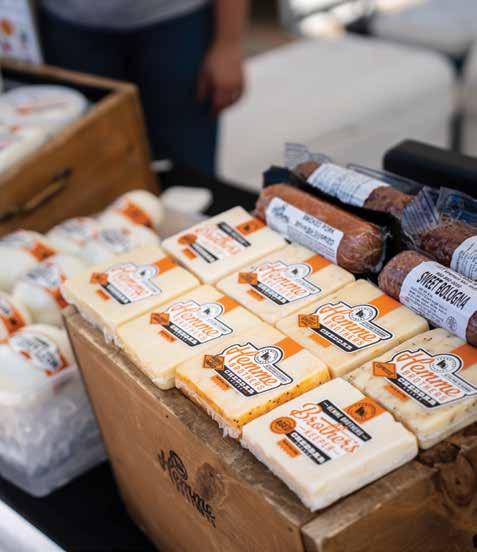
“Our family came over in 1848 from Germany, and we’ve been in the same township ever since, so I'm the seventh generation,” says Nathan, who has four kids of his own.
What makes their Hemme Brothers cheese so special? e cheese is the de nition of farm-totable. e Hemmes raise the cows from which they get their milk, and they grow their own feed for the cows. Fifty-six cows make anywhere from 100 to 150 pounds of cheese per year. e cheeses include a spreadable German-style
quark; an applewood smoked cheddar; two aged cheddars, Brother’s Keeper Aged, and Brother’s Keeper Reserve Aged (those are Nathan’s favorites); and curds that range in avors from ranch and garlic dill cheddar to jalapeño, habanero, and sriracha.
Nathan says they do everything they can to make sure their cattle are as healthy and as happy as possible to ensure the highest quality milk.
“All of our cheeses are handmade in the traditional way with milk from cows that spend their days feeding on avorful grasses, hay, and grain from our own farm. ey produce milk high in butterfat and protein — perfect for rich, avorful cheeses,” the HBFC website says.
Each brother oversees a di erent aspect of the creamery. Jon, 39, oversees the crops grown to feed the cattle; Michael, 34, manages the animal husbandry of the herd; Nathan, 37, makes the cheese; and their father, David, handles sales and
deliveries. e Hemmes opened their dairy in 1996 after switching from raising pigs to raising cattle with the intent of going into the milk industry. en the brothers opened the creamery in 2016 to make and sell cheese using the dairy’s milk. Nathan refers to the creamery as a value-added business.
“So when we started this value-added business, in 2016, our business plan didn't even have us going to the farmers market,” Nathan remembers. “But the more we started to look at markets around the area, [the more we] saw the bene ts they could bring to us to really get our name out there.” e Hemmes started selling at CFM in 2017.
“It always surprises me,” Nathan says, referring to CFM. “It could be a cold, nasty day, or a rainy spring day, or just a hot day in August. It doesn’t really matter; the people of Columbia always show up and support their local farmers.”
e Hemmes do make one product that can only be found at CFM: fresh mozzarella. “ e one thing that we do speci cally for the farmers market — and it’s actually because of the people of Columbia — is mozzarella,” Nathan says with a laugh. “I got tired of listening [to customers ask] for two years, ‘Are you gonna make fresh mozzarella?’ And so they nagged me enough that we started making it and now they won't let me stop.”
You can nd the Hemmes at CFM on Saturdays, and their products are available all over Missouri; the Root Cellar is your best bet in Columbia, and all of the St. Louis Dierbergs.

Matt Arthur, his wife, Laura Hudson, and their 10-year-old daughter, Waverly, own and operate Booneslick Heritage Farm, which specializes in an variety of culinary mushrooms and a host of fresh-cut owers.

Arthur grew up on a farm west of Columbia, just northwest of Midway, while Hudson is from upstate New York; the couple lived there for a while around 2015. e summer growing season is exceptionally short there. Arthur says the last frost usually is sometime during the rst week of June. But they had a damp, dark basement that was perfect for growing mushrooms. As they grew their fungi, they plotted how to get back to Missouri where they could scale up their operation. e family made that move in 2017.
“We have a ower and vegetable farm on my parent’s land, and a mushroom farm just outside of Fulton,” Arthur explains. e family lives in the middle of Columbia; the Arthur land has been in the family for more than 50 years and was once a part of the Boone’s Lick Trail. us the name of the farm: Booneslick Heritage Farm.
Part of what makes the farm special is its commitment to regenerative agriculture and soil health. Arthur’s parents went to no-till farming in the 1990s, and he knew he’d want to do the same with his owers.
“Traditionally, farmers would till or plow to turn the soil over, both to disrupt weeds and also to make a smooth surface for good seed-to-soil contact,” Arthur explains. “In the ‘90s, row crops started to move away from tillage, recognizing that it’s a huge source of soil disturbance that destroys the m icrobiome, and leads to both wind and water erosion. We just knew going into it that we were going to be a no-till farm from the start.”
e owers are grown in permanent raised beds that spend one season a year in a cover crop to ensure the health of the soil. ey even compost their mushroom substrate to add to the beds, and they do sell a variety of compost products, as well.

eir owers include yarrow, snapdragons, narcissus, dahlias, and sun owers.
And because owers are so susceptible to pesticides, they don’t use any chemicals in their operations.
is is the farm’s third year with CFM. You can purchase bouquets from their market stand, as well as buckets of owers if you want to make your own. Waverly makes most of the bouquets you’ll nd at the market. You’ll also nd lion’s mane, blue oyster, and king trumpet mushrooms.
 BOONESLICK HERITAGE FARM 314-347-7568
BOONESLICK HERITAGE FARM 314-347-7568
farmer@blhfarm.com blhfarm.com
‘Shr ms & Bl ms












Our backyard is a peaceful refuge. Just add colorful annuals for sun and shade, hardy perennials (LOVE purple prairie cone owers and African daisies), busy little pollinators, and a teacup Maltese.


 – JODIE JACKSON, DIGITAL EDITOR
– JODIE JACKSON, DIGITAL EDITOR
I love gnomes! I got this cute little guy at Superior Garden, but my puppy quickly played with him like a toy breaking his hat. I was going to throw him away, but my daughter convinced me to make him into a planter. I am so glad I did! He’s so cute.
 – ERICA PEFFERMAN, PUBLISHER
– ERICA PEFFERMAN, PUBLISHER
CHARLES BRUCE,
ese green anoles hang out along my windowsill and like to visit me while I’m working!

 – JORDAN WATTS, SENIOR DESIGNER
DIRECTOR OF
– JORDAN WATTS, SENIOR DESIGNER
DIRECTOR OF
SALES , sent us a random flower and we are not sure if he had anything to do with its growth, or if he pulled it from Getty images.
Knowing that I have zero green thumb, our publisher and my dear friend Erica, bought me this succulent in the cutest pig planter, with promises that it is nearly impossible to kill it. We can all see how this has turned out. is lil’ piggy has de nitely seen better days.
 – KIM AMBRA, EDITOR-IN-CHIEF
– KIM AMBRA, EDITOR-IN-CHIEF
Each of our pursuits has a bigger purpose. We look beyond today’s horizon to build a healthy world for our future.
The College of Agriculture, Food & Natural Resources at the University of Missouri is shaping the next generation by placing nearly 100% of our graduates in meaningful careers.


Our cutting-edge researchers are leaders in agricultural production, life sciences, weather and agricultural policy.
CAFNR is solving the biggest challenges in our world today, including food insecurity, drought and flood, and environmental sustainability.